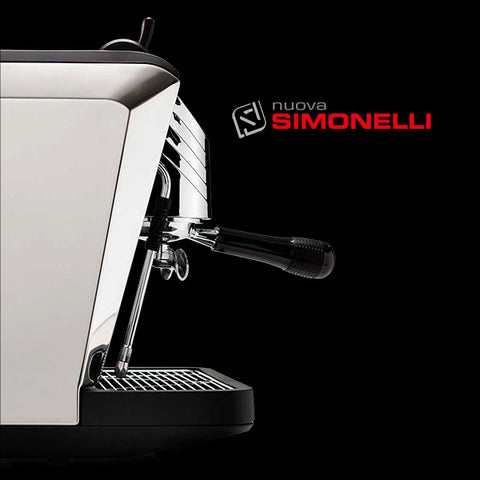
Hello espresso lover,
Several of you have purchased an Oscar and I believe that overall everyone is satisfied with their machine. I would like to make an aside for Oscar holders and for those who are thinking of buying one which follows an email exchange that I had this week with a good customer from the Gaspé region who was experiencing certain problems with his Oscar, which turned out to be normal limitations of the machine.
First of all, our equipment offer in the semi-pro range is mainly occupied by the Nuova Simonelli Oscar and the Rancilio Silvia. I really like both machines, and despite their differences, they deliver excellent coffee that beats Saeco, Breville and residential machines hands down. And I won't talk about full-automatic machines... I won't dwell on the difference between the Silvia and the Oscar either, but will simply say that the Oscar is superior to the Silvia on several points.
So I have a weakness for the Oscar which allows you to have a machine (+ mill) for around $1500, which contains and reacts like a commercial one, has commercial components, solenoid, a 58mm filter holder, a heat system exchanger, a good capacity kettle allowing you to froth and extract an espresso at the same time.
And as a customer asked me recently: “If I were your sister, what machine would you recommend?” , I answer, depends on the budget. #1 a La Marzocco GS/3, #2 Nuova Simonelli Musica #3 Nuova Simonelli Oscar. #4 Rancilio Silvia.
Given the popularity of the Oscar among our customers, I would like to outline the two technical details discussed this week in order to get to know this machine better.
Situation #1:
[...] It seems that the pump is not working automatically. Even if I add a full tank of water, the pump does not start. On the other hand, if I turn the machine off, press the button to make the water flow, and put the machine "on", the pump works and the water flows for about 5 seconds. Then it stops and the fill light comes on. So the pump is not broken. But only the thing-thing that detects the water level. There is no water or steam coming out of the steam wand even when it is hot and open. [...]
Solution:
After some tests it turned out that the water used, a well-known brand of spring water, was so poor in minerals that the conduction between the bottom of the kettle and the level probe did not detect the water. Using tap water, the machine worked normally.
The probe (#6) sends a slight electrical current through the water, which passes through an anode at the bottom of the kettle and tells the machine the level. If the electrical current does not flow, the machine using water as a conductor, this indicates a lack of water, stopping the pump and turning on the fill indicator light.
So, because of this design, do not use distilled water, in any case, well mineralized water will better absorb the coffee solubles.
Situation #2
[…] The steam nozzle has no pressure even after 15 minutes of heating. You have to open it once, close it again and wait a few more minutes. Afterwards it works. […]
Solution:
A phenomenon called "False pressure" occurs on Heat exchanger type machines like the Oscar. We do not find this phenomenon on machines equipped with PID, such as the GS/3 from La Marzocco. Or in the case of the Musica or the Simonelli commercials, a vacuum breaker valve overcomes the problem.
 In the kettle, when you close the machine and the temperature drops, the steam condenses and slightly increases the volume of water in the kettle, thus creating a vacuum in the kettle. When you turn the coffee maker back on, the heat creates an expansion of the air and the machine is unable to reach its ideal temperature of the air-steam-water mixture because the more rapid expansion of the air makes it appear as if pressure switch that the pressure is ok, which is false. Then the pressure switch sends the signal to stop the heating element and turns on the indicator light indicating that the machine is ready. You can make an espresso without any problem at this stage but the pressure will be lower, as will the temperature, thus giving a mediocre result.
In the kettle, when you close the machine and the temperature drops, the steam condenses and slightly increases the volume of water in the kettle, thus creating a vacuum in the kettle. When you turn the coffee maker back on, the heat creates an expansion of the air and the machine is unable to reach its ideal temperature of the air-steam-water mixture because the more rapid expansion of the air makes it appear as if pressure switch that the pressure is ok, which is false. Then the pressure switch sends the signal to stop the heating element and turns on the indicator light indicating that the machine is ready. You can make an espresso without any problem at this stage but the pressure will be lower, as will the temperature, thus giving a mediocre result.
And when you open the steam nozzle, you let out the expanding air, the pressure switch realizes that the pressure was too low and drops back to heating mode for a few minutes, thus correcting the imbalance in the water-steam-air ratio.
The situation encountered with steam is therefore normal and also comes from a design detail to reduce the price of the machine. On commercial models, or on the Musica, we find a part called a "vacuum-breaker valve" which allows you to start the machine from the room temperature, to let the pressure rise in the kettle, and which equalizes the pressure without need to do the procedure of opening the steam valve, letting out the excess pressure and waiting for the machine to balance everything.
So it's normal. We can anticipate this phenomenon on the Oscar in the following way: when you turn it off, you can put the steam nozzle in a stainless steel pitcher and open the valve to let the steam escape and thus prevent a certain condensation in the kettle when cooling
You can also, after a few minutes of heating, open the steam valve to balance the pressure from the start and thus not waste preheating time.
The machine can also be modified to install a vacuum breaker valve and a timer.
**************** Added August 1, 2013 ****************************** *****
Someone just brought me an Oscar with the following symptoms:
- smell of burnt rubber coming from the steam
- Water and condensed steam brownish and not very appetizing...
Result: the milk is execrable after steaming.
Although it does not happen very often, this situation is the result of ignorance of how the machine works. As mentioned above, we must anticipate the phenomenon and manage the expanding air in the kettle. If you do not purge the kettle with the nozzle, and after turning it on you immediately put the steam nozzle in milk, completely submerged, when you open the valve, the pressure in the kettle will try to equalize through the nozzle. A vacuum will then be created, and milk will be sucked directly into the kettle! The milk will burn and end up in the heat exchanger section. Hence the brown color and the burning smell...
And once in, even if you rinse your machine for hours you won't get rid of the smell and bad taste. At least, I wasn't able to do it with a simple rinse (or even several). We must therefore, for a simple operating error, open the machine, empty the kettle completely, rinse it and treat it with a conventional acid or detergent-descaling agent. Which is still a good job...
This is what the water that was in the kettle looks like after sucking up milk! I took the kettle apart and poured the water into this pitcher. I'll let you imagine what a cappuccino might taste like...

Completely disassembling the Oscar, cleaning the kettle and putting it back together takes at least 4 hours. So, it all depends on the price of your preferred repairer, it will cost you around $250-300 to get your machine back into working order.
So, as my client told me today: "Never let the tour touch my espresso machine again!" :-)
Although these situations may be perceived as problems or defects, they are in fact normal situations caused by a design intended to be as close as possible to the quality of commercial machines at a price oriented towards residential machines.
The Oscar remains one of my favorite machines for the home or even small business.
A barista forewarned is worth two!
Danny Marquis





Comments (7)
J’attend pour bientôt une Rocket Cinquantotto et je fais beaucoup de lecture pour être Barista ( en attendant que les cours puissent se donner) . Les manuels parlent souvent de la qualité de l’eau ( minéraux). Étant de Montréal, je préfère acheter de l’eau pour mes Espresso. Pouvez-vous me recommander quoi acheter svp, ( je déménage bientôt donc ne raccorderai pas le système à l’eau courante avec système de filtration). Merci
Mon commentaire pour la pincée de sel était pour une machine Oscar de Simonelli.
Lorsque vous effectuez un remplissage du réservoir d’eau en utilisant une eau pauvre en minéraux et que le senseur du niveau d’eau ne revient pas à la normale, ajoutez simplement une petite pincée de sel dans l’eau qui fera office de minéraux.
Il se peut que vous ayez à actionner le bouton de la pompe à quelques reprises mais la situation reviendra à la normale à coup sûr après quelques essais.
Bonjour Sylvie, travailler avec de l’eau distillé dans une machine espresso est l’ultime façon de ne pas avoir de problème d’accumulation de minéraux. Toutefois, c’est au détriment du goût car un café préparé avec de l’eau distillé ne sera jamais à la hauteur d’un café préparé avec de l’eau ’’normal’’ contenant des minéraux. Seaco recommande l’utilisation d’un filtre adoucisseur sur plusieurs de ses modèles. C’est la façon la plus efficace de travailler, avec un adoucisseur d’eau et malheureusement l’accumulation de minéraux est inévitable. L’utilisation d’une eau contrôlé (en bouteille) vous permettra d’avoir plus de contrôle sur l’accumulation de minéraux et dans votre routine de détartrage.
j ai vu votre information sur le café concernant l eau 💦!! ns avons une Saeco la boutique ns ont dit que de prendre seulement de l eau distillée.., 😳 et vs vs dites se tenir loin de l eau distillée?!? je suis perplexe éclairé moi svp
Vous dites “On peut également modifier la machine pour installer une vacuum breaker valve et un timer.”
Puis-je avoir une idée du coût de cette modification ?
Merci Dany, la description et la solution des deux irritants sur la Oscar m`ont été vraiment utile. Vraiment bien expliqué.
René